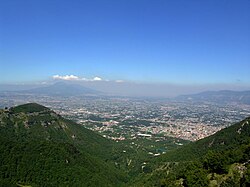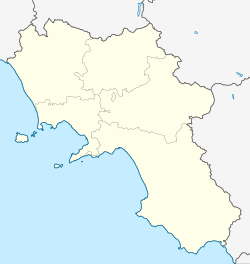Nocera dei Pagani
You can help expand this article with text translated from the corresponding article in Italian. (June 2023) Click [show] for important translation instructions.
|
Nocera dei Pagani | |
|---|---|
| Nuceria Paganorum | |
 Views of Nocera dei Pagani. | |
| Coordinates: 40°44′N 14°37′E / 40.733°N 14.617°E | |
| Country | Italy |
| Region | Campania |
| Province | Province of Salerno |
| Area | |
• Total | 62 km2 (24 sq mi) |
| Demonym | Nucerian[a] |
| Time zone | UTC+1 (CET) |
| • Summer (DST) | UTC+2 (CEST) |
| Postal code | 84010; 84014 to 84016 |
| Patron saint | St. Alphonse |
| Saint day | 1 August |
Nocera dei Pagani[b] (Latin: Nuceria Paganorum), as it was known between the 16th century and 1806, was a civitas that included a large portion of the Agro nocerino-sarnese, corresponding to five contemporary municipalities: Nocera Inferiore, Nocera Superiore, Pagani, Sant'Egidio del Monte Albino and Corbara.
History
[edit]Nuceria
[edit]In the period before the Roman supremacy in southern Italy, the whole territory was known as Nuceria, the chief town in the Sarnus valley – Herculaneum, Pompeii, Stabiae and Surrentum all being dependent upon it, according to many archaeologists. It maintained its allegiance to Rome until 309 BC, when it joined the Samnites in revolt.[1] In 308 BC it repulsed a Roman attempt to land at the mouth of the Sarnus, but in 307 BC it was besieged and surrendered. It obtained favourable terms, and remained faithful to Rome even after the Battle of Cannae.[1]
In 216 BC Hannibal weakened the town by starvation, then destroyed it. The inhabitants returned when peace was restored. During the Social War, it remained true to Rome. In 73 BC it was plundered by Spartacus.[1]
Saracen colony
[edit]In the Middle Ages (around the 9th century) a small colony of Saracens was introduced in the annexed territory of modern-day Pagani by permission of the Dukes of Naples; according to most sources, it lasted only a few decades, but other sources state that a second colony of Muslim Saracens was later introduced by Frederick II.[2] The town was described as a genuine Muhammadan town with all its characteristic mosques and minarets.
[3] It is said that, through their darker complexion and features, the townsfolk maintain the heritage of these Muslim settlers.[4]
After the mid-9th century the town was part of the principality of Salerno first, and then of the principality of Capua.
Pagano family
[edit]The House of Pagano, an ancient noble family of local lords living in the castle of Cortimpiano (Latin: Curtis in Plano), in the territory of Pagani, apparently took this surname from the Saracens (referred to as "pagans") who previously inhabited the area.
Second millennium
[edit]The citadel of Nuceria, located where the future Nocera Inferiore would rise, was besieged by Roger II of Sicily in the battle in 1132. After four months he razed the town to the ground. After its reconstruction, the birth of the modern Nocera began with many hamlets and villages which gradually expanded and became small towns.
During the Angevin dominion (1266–1435) Nocera was rebuilt and took the name of Nuceria Christianorum (Italian: Nocera dei Cristiani, lit. 'Nocera of the Christians'). In 1385 Pope Urban VI was besieged in the city castle by Charles III of Naples.
In the 15th century the town name was changed to Nuceria Paganorum (Italian: Nocera dei Pagani, lit. 'Nocera of the Pagans') in honor of the Pagano family, itself named after the Saracen pagans who previously inhabited the area. Throughout the Spanish domination, the town was subdivided into two departments (Nocera Soprana and Nocera Sottana), each one composed of multiple municipalities.
Every year in August, the male adults of each municipality gathered in public assembly to elect their particular mayor; then – in a different assembly – each department elected the universal mayors: two for Nocera Soprana and one for Nocera Sottana, which together led Nocera dei Pagani as a triumvirate.
| Department | Municipality | Territory |
|---|---|---|
| Nocera Soprana | ||
| ||
| ||
| ||
| ||
| Nocera Sottana | ||
The town survived until 1806. In 1807 five comuni were established: Barbazzano merged into the comune of Pagani; Sperandei merged into San Matteo Tre Casali,[d] forming the comune of Nocera San Matteo; while Nocera Corpo, Sant'Egidio and Corbara stayed autonomous. In 1834, the remnants of Nocera Soprana (Nocera Corpo and Nocera San Matteo) merged back into a single comune, but fourteen districts of Nocera Corpo (including Pucciano)[g] later asked for self-administration, which was granted by decree No. 1960 on 11 November 1850, with effect from 1 January 1851; thus were born the contemporary comuni of Nocera Superiore (corresponding to most of Nocera Corpo) and Nocera Inferiore (formerly Nocera San Matteo).
See also
[edit]- History of Islam in southern Italy
- Diocese of Nocera dei Pagani
- Nucerian alphabet
- Pagani, Campania
- Ugo dei Pagani
Notes
[edit]- ^ See Nucerian alphabet.
- ^ Often shortened as Nocera de' Pagani.
- ^ Districts of Piedimonte, Pietraccetta and Borgo.
- ^ a b c Tre Casali was autonomous from the 1500s to the 1700s, then merged into the municipality of San Matteo, forming San Matteo Tre Casali.
- ^ Districts of San Matteo, Merichi and Liporta.
- ^ Districts of Capo Casale, Casale Nuovo and Casale del Pozzo.
- ^ a b Formerly part of Nocera Corpo, Pucciano was autonomous from 1570 to 1580, then merged back into the municipality of Nocera Corpo.
References
[edit]Citations
[edit]- ^ a b c Belsito & De Pascale 2013.
- ^ Chisholm 1911, p. 730.
- ^ Browning 1984, p. 300.
- ^ Scott 2013, p. 470–1.
Works cited
[edit]- Accattatis, Luigi (1869). Le biografie degli uomini illustri delle Calabrie (in Italian). Vol. I. Cosenza: Tipografia Municipale. p. 68.
- Amico, Antonino (1636). Brevis et exacta notitia originis Sacrae Domus Templi (in Latin). Palermo.
- Baedeker, Karl (1869) [1867]. Italy: handbook for travellers (in English and German). Vol. III (2 ed.). Coblenz. p. 145.
{{cite book}}: CS1 maint: location missing publisher (link) - Belsito, Francesco; De Pascale, Carmine (2013). Storia di Pagani. Monumenti, personaggi, tradizioni (in Italian). Angri: Gaia.
- Benigni, Umberto (1911). "Nocera dei Pagani". Catholic Encyclopedia. By VV.AA. Vol. XI. New York: Robert Appleton Company. p. 11087a. Archived from the original on 16 December 2023.
- Browning, Robert (1984). The Poetical Works of Robert Browning. Vol. II. Strafford, Sordello (reprint, annotated ed.). Clarendon Press. p. 300. ISBN 9780198123170.
- Chisholm, Hugh, ed. (1911). . Encyclopædia Britannica. Vol. 19 (11th ed.). Cambridge University Press. p. 730.
- Campanile, Filiberto (1610). L'armi, overo le insegne dei nobili (in Italian). Naples: Tarquinio Longo. p. 253.
- De Pagan, Blaise François (1668) [1645]. Les fortifications du comte de Pagan (in French) (2 ed.). Bruxelles [Paris]: François Foppens [Cardin Besogne].
- De Pagan, Blaise François (1669). Divers ouvrages de Monsieur le comte de Pagan, trouvés dans ses écrits aprês sa mort (in French). Vol. 3.
- Dupuy, Pierre (1713) [1654]. "Histoire de la condamnation des Templiers". Histoire de France (in French) (2 ed.). Bruxelles [Paris]: Pierre Foppens [Edme Martin]. Archived from the original on 29 May 2016. Retrieved 16 June 2024.
{{cite book}}: CS1 maint: bot: original URL status unknown (link) - Dupuy, Pierre (1751) [1654]. Histoire de l'ordre militaire des Templiers (in French) (2 ed.). Bruxelles [Paris]: Pierre Foppens [Edme Martin]. p. 2.
- Gaetani, Costantino (1638). Vita di Papa Gelasio II [Life of Pope Gelasius II] (in Latin and Italian).
- Giustinian, Bernardo (1692). Historie cronologiche dell'origine degl'ordini militari e di tutte le religioni cavalleresche (in Italian). Vol. I. Venice: Combi e LàNoù. p. 307. Archived from the original on 6 September 2023.
- Gradilone, Alfredo (1967). Storia di Rossano (in Italian) (2 ed.). Cosenza: MIT. Archived from the original on 5 July 2015.
- Guarini, Marco Antonio (1621). Compendio historico di Ferrara (in Italian). Vol. IV. Ferrara: Vittorio Baldini. p. 224.
- Hofmann, Johann Jacob (1698). Lexicon universale (in Latin and German). Leiden: Jordaan Luchtmans. pp. 547, 942, 945.
- Mazzella, Scipione (1596) [1588]. Le vite dei re di Napoli: con le loro effigie dal naturale (in Italian) (2 ed.). Naples: G. Bonfadino [G. Cacchi].
- Mennens, Frans (1623). Militarium ordinum origines (in Latin). Macerata: Pietro Salvioni. p. 34.
- Moiraghi, Mario (2005). L'italiano che fondò i Templari – Hugo de Paganis: cavaliere di Campania (in Italian). Milan: Àncora. ISBN 978-8851402792.
- Moiraghi, Mario (2013). "Le prove della sua origine" [The proofs of his origin]. Hugo de Paganis (in Italian). Vol. I. Nave senza nocchiere.
- Pantaleon, Heinrich (1581). Militaris ordinis Johannitarum, Rhodiorum aut Melitensium equitum historia (in Latin). Basel: Thomas Guarin. p. 23.
- Rotundo, Domenico (1983). Templari, misteri e cattedrali (in Italian). Rome: Templari. p. 38. ISBN 9788865010006. Retrieved 8 September 2023.
Ho scritto a mio padre in Nocera che mi faccia gratia venire a Rossano per consolare V.S. et a Madama Zia Hippolita
- Sigonio, Carlo (1574). Historiarum de regno Italiae (in Latin). Vol. XI. Venice: Giordano Ziletti. p. 427. Archived from the original on 2 July 2015.
- Scott, Walter (31 August 2013). Douglas, David (ed.). The Journal of Sir Walter Scott. Vol. 2: From the Original Manuscript at Abbotsford (illustrated ed.). Cambridge University Press. pp. 470–1. ISBN 9781108064309.
In the latter village [Nocera Inferiore] the Saracens obtained a place of refuge, from which it takes the name. It is also said that the circumstance is kept in memory by the complexion and features of this second Nocera, which are peculiarly of the African caste and tincture.
Further reading
[edit]- Fortunato, Teobaldo, ed. (2006). Nuceria, scritti in onore di Raffaele Pucci (in Italian). Postiglione (SA).
{{cite book}}: CS1 maint: location missing publisher (link) - Orlando, Gennaro (1888). Storia di Nocera de' Pagani (in Italian). Naples.
{{cite book}}: CS1 maint: location missing publisher (link) - Silvestri, Salvatore (1993). S. Egidio tra storia e leggenda. Appunti, ipotesi e documenti dal 216 a.C. al 1946 (in Italian).
- Silvestri, Salvatore; Vollaro, Salvatore (2001). S. Egidio, S. Lorenzo e Corbara. La storia e le famiglie (in Italian).
- Silvestri, Salvatore (2010). S. Egidio. Un luogo chiamato Preturo (in Italian). Edizioni Gaia. ISBN 978-88-89821-75-6.



